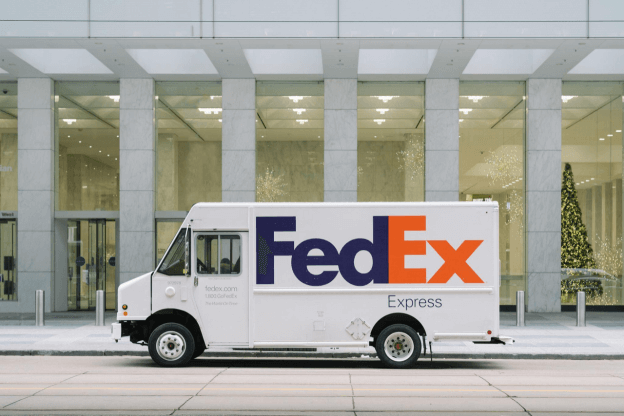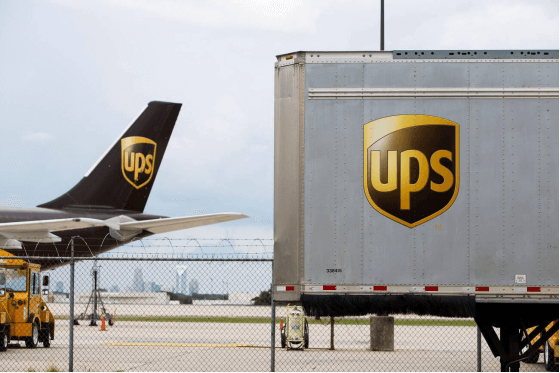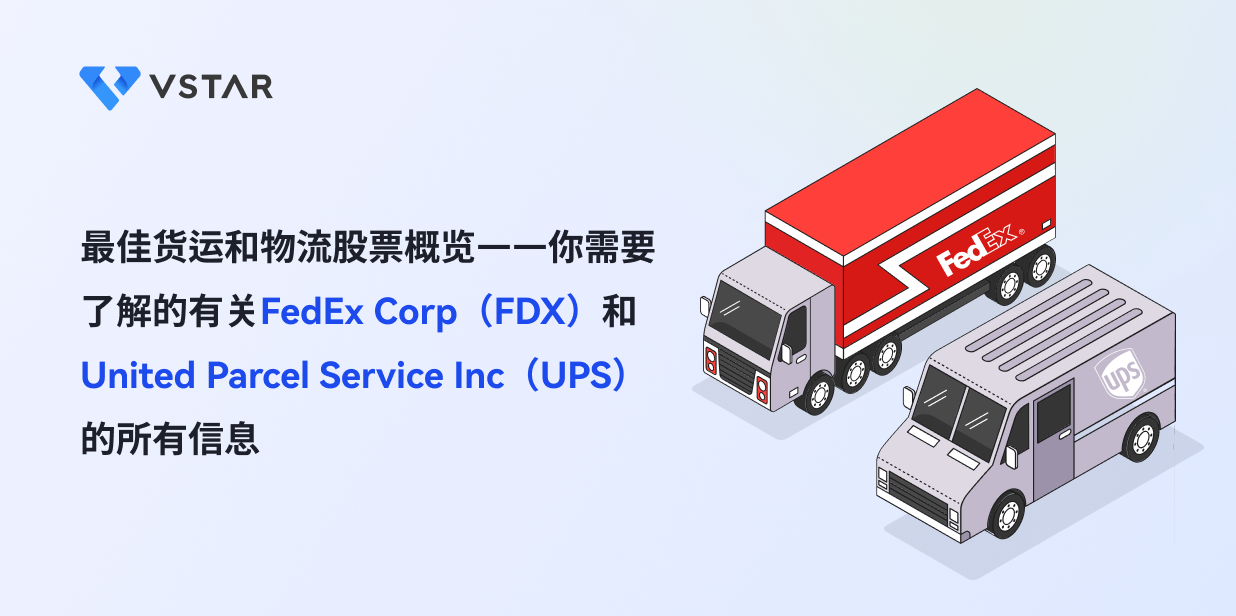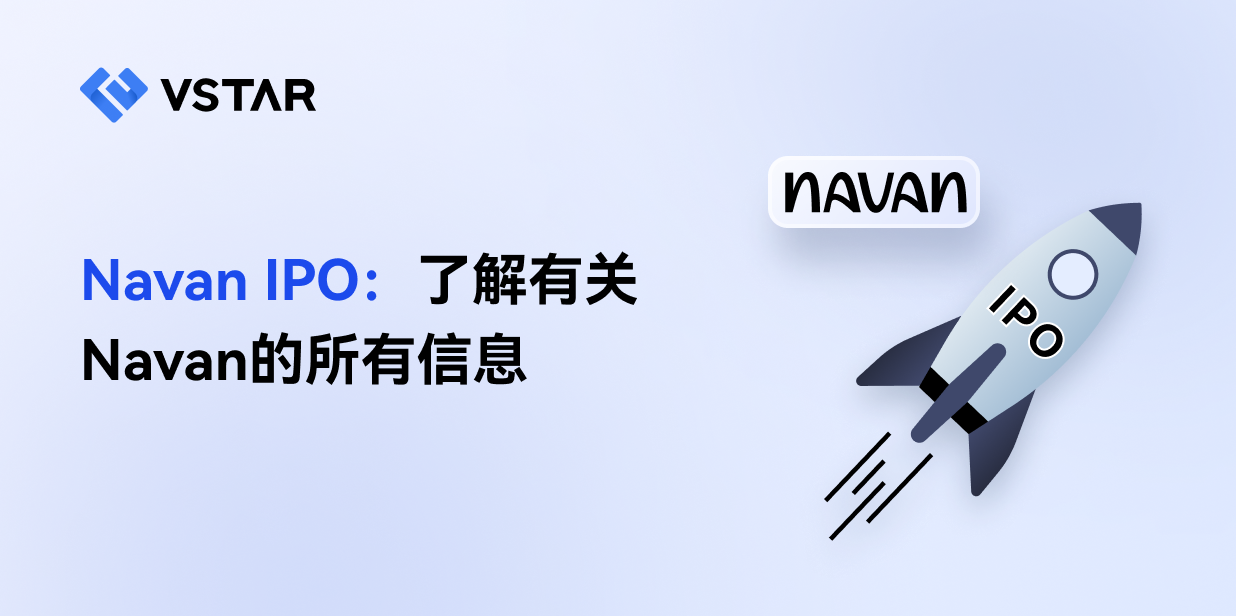货运和物流业是全球经济的重要组成部分,因为它促进了货物和服务的跨境和跨区域流动。据报导,2022年全球货运和物流业价值约为10.68万亿美元,到2032年将超过18.23万亿美元。该行业包括各种运输方式,如航空、铁路、公路和水路,以及各种活动,如货运代理、仓储、配送、清关等。
投资货运和物流行业可以为投资者带来多项好处,例如接触多样化和不断增长的市场、稳定的现金流和潜在的股息。此外,投资该行业还可以接触到一些世界上最大、最成功的运输和物流公司,例如联邦快递公司(FDX)和联合包裹服务公司(UPS)。这两家巨头几十年来一直主导著全球市场,每天运送数百万个包裹。他们还一直在创新和扩展业务,以满足客户和市场不断变化的需求。
在本文中,我们将为你深入分析FedEx和UPS的股票、它们的商业模式和产品/服务、它们的增长催化剂和近期表现、它们的股票交易信息和比较,以及你如何使用它们进行投资VSTAR上的差价合约,这是一个全球受监管的交易平台,可让你轻松进入1000多个市场交易。
联邦快递公司(纽约证券交易所代码:FDX)
FedEx Corp(纽约证券交易所代码:FDX)是世界领先的运输和物流公司之一,在全球范围内提供运输服务,包括快递运输和地面小包裹递送。该公司经营FedEx Express、FedEx Ground、FedEx Freight和其他为客户和企业提供各种解决方案的部门。
FedExCorp于1971年由耶鲁大学毕业生Frederick W. Smith创立,他的愿景是建立一个专为紧急递送而设计的系统。他筹集了9100万美元的风险投资,并于1973年创立了这家拥有389名团队成员和14架飞机的公司,在运营的第一个晚上就向美国25个城市运送了186个包裹。从那时起,联邦快递已成长为拥有超过600,000名团队成员和680多架飞机,服务于220多个国家和地区的全球巨头。
FedEx Corp总部位于田纳西州孟菲斯市,由Frederick W. Smith担任执行主席,Raj Subramaniam担任总裁兼首席执行官。公司市值约为568.4亿美元,2023财年净收入约为7.71亿美元。

来源:Unsplash
FedEx Corp于1978年在纽约证券交易所上市,股票名称为FDX。股票以美元交易,遵循纽约证券交易所的交易时间,即东部时间工作日上午9:30至下午4:00。该股票还有上市前和上市后交易时段,分别从上午4:00到上午9:30和下午4:00到晚上8:00。联邦快递公司从未进行过股票分割,但它每季度向股东支付股息。最新的股息为每股1.15美元,于2023年4月3日支付。投资者和交易员应注意的一些最新进展是:
- 联邦快递于2023年3月16日公布了2023财年第一季度业绩,营收为222亿美元,同比下降5.9%,摊薄后每股收益为3.05美元,同比下降27.4%。
- FedEx于2022年9月15日宣布,将从2022年1月3日起提高FedExExpress、FedEx Ground、FedEx Home Delivery、FedEx Freight和FedEx Smart Post服务的运费。美国国内的平均运费涨幅为5.9%,美国出口和美国进口服务。
- 联邦快递于2022年8月24日宣布,它将收购ShopRunner,这是一个将在线购物者与他们最喜欢的零售商和品牌联系起来的电子商务平台。此次收购将增强联邦快递的电子商务能力,并为其客户提供更多利益。
联合包裹服务公司(纽约证券交易所代码:UPS)
United Parcel Service Inc(纽约证券交易所代码:UPS)是全球最大的包裹递送公司,也是全球领先的专业运输和物流服务提供商。该公司提供全球信件和包裹递送、运输和物流解决方案,服务于220多个国家和地区。
United Parcel Service Inc于1907年由19岁的James E. Casey和另一名少年Claude Ryan在西雅图创立,当时是美国信使公司。他们从借来的100美元开始,跑腿,步行或骑自行车送货。1919年,公司扩展到加利福尼亚州奥克兰,并采用了United Parcel Service这个名称。它还将其车辆涂成深棕色,象征着阶级、成熟和专业。多年来,UPS成长为拥有超过530,000名员工和超过115,000辆汽车的全球巨头。
United Parcel Service Inc总部位于佐治亚州亚特兰大,Carol Tomé是首席执行官。公司2023年第一季度市值约1458亿美元,净收入约19亿美元。

来源:Unsplash
United Parcel Service Inc于1999年作为UPS在纽约证券交易所上市。该股票以美元交易,并遵循纽约证券交易所的交易时间,即东部时间工作日上午9:30至下午4:00。该股票还有上市前和上市后交易时段,分别从上午4:00到上午9:30和下午4:00到晚上8:00。United Parcel Service Inc每季度向其股东支付股息。最新的股息为每股1.62美元,于2023年3月10日支付。投资者和交易员应注意的一些最新进展是:
- UPS于2023年4月25日公布第一季度业绩,营收为229亿美元,同比下降6.15%,摊薄后每股收益为2.19美元,同比下降27.87%。
- 2022年8月3日,UPS宣布将收购Roadie,这是一个将本地和全国企业与能够快速高效地送货的司机联系起来的当日送达平台。
- 2022年9月9日,UPS宣布自2022年10月4日起提高UPSGround、UPS Air和International服务的运费。美国国内服务的平均运费涨幅为4.9%。
FedEx和UPS的增长催化剂

来源:Unsplash
FedEx和UPS拥有可以促进其长期增长的关键增长催化剂。
● 电子商务增长推动运输量增加
大流行促进了在线购物,对包裹递送服务产生了更多需求。FedEx和UPS一直在通过提供更快的交付选项、增强其网络和设施以及与在线零售商和平台合作来扩展其电子商务能力。
● 企业对企业的航运也保持强劲
FedEx和UPS在企业对企业(B2B)领域占有重要地位,约占其总收入的60%。B2B运输涉及在企业之间运输货物和材料。随着工业生产、贸易活动和消费者需求的增加,这一领域已经从大流行引起的放缓中恢复过来。FedEx和UPS一直在投资于他们的B2B能力,例如提供更可靠和灵活的服务,改进他们的技术和自动化,以及使他们的客户群多样化。
● 国际市场提供了扩张的机会
FedEx和UPS的业务遍及全球,分别为220多个国家和地区提供服务。然而,它们在亚太、拉丁美洲、非洲和中东等新兴和高增长市场仍有增长空间。这些地区为FedEx和UPS提供了诱人的机会,以利用不断壮大的中产阶级消费者、日益增长的跨境电子商务贸易以及对物流解决方案不断增长的需求。FedEx和UPS一直在寻求各种战略来扩大其国际影响力,例如收购当地公司、组建合资企业或联盟、推出新服务或航线,以及加强其基础设施和运营。
● 无人机交付等创新可以促进长期增长
FedEx和UPS投资于创新和技术,以提高效率、生产力、客户体验和可持续性。他们正在探索的领域之一是无人机交付,它可以提供更快、更便宜、更安全和更环保的交付解决方案。两家公司一直在各种市场和场景中测试和试点无人机送货服务。
最近的表现和展望

来源:Unsplash
受益于大流行期间对航运服务的需求增加,联邦快递和UPS在2022年取得了强劲的财务业绩。然而,他们在2023年也面临着一些挑战和不确定性,例如成本上升、劳动力挑战、供应链中断和竞争压力。以下是两家公司近期的一些业绩和前景亮点:
FedEx和UPS的近期收益、收入和股价趋势
联邦快递公布截至2023年2月28日的第一财季收入为222亿美元,同比下降5.93%,摊薄后每股收益为3.05美元,同比下降27.38%。UPS公布截至2023年3月31日的第一季度收入为229亿美元,同比下降6%,摊薄后每股收益为2.19美元,同比下降27.9%。两家公司的收益均超过分析师预期,但联邦快递的收入低于预期,而UPS的收入超过预期。联邦快递股价在2023年5月30日收于226.14美元,年初至今上涨27.57%,而UPS同日收于169.76美元,年初至今下跌3.15%。
公司的前景和分析师预期
联邦快递以更高的收入增长和削减成本的举措为由,上调了2023财年的指引。该公司预计收入为910至940亿美元,营业利润率为7.5%至8%,摊薄后每股收益为18.25至19.50美元。UPS还上调了2023年全年的业绩预期,预计收入约为1040亿美元,营业利润率约为14%,摊薄后每股收益为14.60美元至15.20美元。分析师普遍预计联邦快递的收入为915亿美元,联合包裹的收入为1,012.2亿美元,而联邦快递的每股收益估计为18.38美元,联合包裹的每股收益为11.88美元。
哪个更好,FedEx或UPS?
FedEx和UPS是运输和物流行业的领先者,但它们的优势和劣势各不相同,这影响了它们作为投资的吸引力。以下是比较两家公司时需要考虑的一些因素:
● 估值
根据市盈率(P/E)、市销率(P/S)和市账率(P/B)等多项指标,联邦快递的估值低于UPS。截至2023年5月31日,联邦快递的过去12个月市盈率为19.67,市盈率为0.64,市账率为2.32,而UPS的过去12个月市盈率14.22,P/S比率为1.55,P/B比率为7.53。这表明联邦快递在从其资产中产生收入和股本方面比UPS更有效率,但在收益方面不如UPS。
● 分红
UPS的股息收益率高于联邦快递,这表明它向股东支付的费用高于其股价。截至2023年5月31日,UPS的年股息收益率为3.82%,而联邦快递的年股息收益率为2.23%。UPS在支付和增加股息方面的历史也比FedEx更长。UPS从1969年开始派息,已经连续12年上调,而FedEx从2002年开始派息,已经连续9年上调。
● 资产负债表
UPS的资产负债表比联邦快递更强大,联邦快递比竞争对手拥有更多的现金和更少的债务。截至2023年3月31日,UPS拥有62亿美元的现金和等价物以及199亿美元的长期债务,而联邦快递拥有54亿美元的现金和等价物以及201亿美元的长期债务。
● 竞争地位
FedEx和UPS在运输物流行业的竞争地位不同,市场份额和细分领域也不同。联邦快递在航空货运市场占据主导地位,因为它拥有全球最大的货机机队,并经营著最大的快递网络。UPS在地面递送市场占据主导地位,因为它拥有世界上最大的递送车队并运营著最大的包裹递送网络。两家公司都面临来自亚马逊、DHL和各种初创公司等其他参与者的竞争。
● 增长潜力
FedEx和UPS在运输和物流行业具有相似的增长潜力,因为它们受益于塑造该行业未来的一些关键趋势和驱动因素,例如电子商务增长、企业对企业航运复苏、国际扩张和创新.然而,他们也面临成本上升、劳动力短缺、供应链中断和竞争压力等挑战和不确定性。
该分析表明,对于重视股息的收入投资者,UPS比FedEx更具吸引力,而对于重视效率的成长型投资者,FedEx比UPS更具吸引力。然而,两家公司在运输和物流行业有着相似的增长前景和面临相似的风险。
如何投资FDX和UPS股票

来源:Unsplash
要投资FDX和UPS股票,你可以选择以下三种方式之一:持有股票、购买期权或交易差价合约。每种方式都有利有弊,但差价合约交易有一些独特的优势,例如低成本和高灵活性。你可以用少量存款进行交易,从任何价格方向获利,并避免佣金、费用和溢价。你无需拥有差价合约的实际股份。
如果你希望通过VSTAR交易FDX和UPS股票差价合约,以下是选择该平台的一些理由。VSTAR允许你在各种市场上交易差价合约,例如货币、股票、指数和商品。你可以在VSTAR享受低费用、快速执行和安全交易。你还可以使用其用户友好的应用程序,从小额存款开始,然后使用模拟账户进行练习。为了你的方便,VSTAR支持多种支付方式。
要使用VSTAR交易FDX和UPS股票差价合约,请遵循以下简单步骤:
- 访问vstar.com或在你的设备上下载VSTAR应用程序。
- 通过提供你的详细信息、电子邮件地址、电话号码等来注册一个账户。
- 通过上传你的身份证明和地址来验证你的身份。
- 选择你喜欢的付款方式和金额,将资金存入你的账户。
- 通过从可用工具列表中选择FDX或UPS开始交易,输入你的交易规模、方向(买入或卖出)、止损、止盈等,然后单击“打开交易”。
结论
本文提供了通过在VSTAR交易FDX和UPS股票差价合约来投资货运和物流行业的综合指南。它讨论了FedEx和UPS这两家世界上最大的运输和物流公司的历史、商业模式和股票交易信息。此外,我们还讨论了公司的增长催化剂和比较因素,以及为什么UPS股票比FedEx股票更具吸引力。
我们还探讨了投资FDX和UPS股票的三种方式,以及为什么CFD交易是你的最佳选择。最后,我们提到了选择VSTAR作为你的FDX和UPS股票差价合约交易平台的原因,以及如何使用VSTAR轻松快速地交易FDX和UPS股票差价合约。要了解有关差价合约交易的更多信息或开始使用VSTAR交易FDX和UPS股票差价合约,请访问www.vstar.com或立即下载VSTAR应用程序。
*免责声明:本文内容仅供学习,不代表VSTAR官方立场,也不能作为投资建议。




















